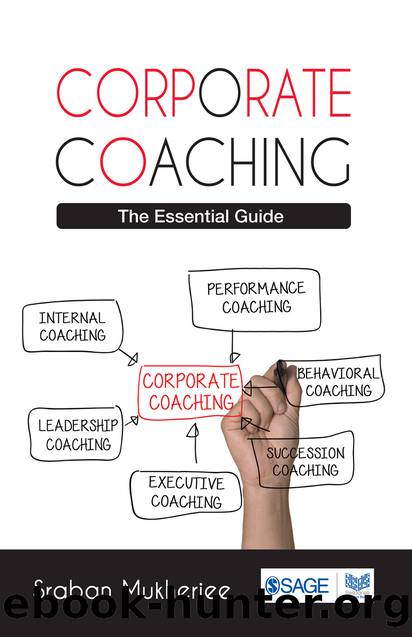Corporate Coaching by Mukherjee Sraban;

Author:Mukherjee, Sraban;
Language: eng
Format: epub
Publisher: SAGE Publications India Pvt, Ltd.
Published: 2015-05-25T03:44:47+00:00
Chapter 6
Coaching for Talent Management
What Is Talent Management?
The Chartered Institute of Personnel and Development (CIPD) defines talent âas of those individuals, who can make a difference to organizational performance either through their immediate contribution or, in the longer term, by demonstrating the highest levels of potential.â CIPD defines talent management as, â⦠the systematic attraction, identification, development, engagement, retention and deployment of those individuals who are of particular value to an organization, either in view of their âhigh potentialâ for the future or because they are fulfilling business/operation-critical roles.â According to American Society of Training and Development (ASTD), âTalent management is a holistic approach to optimizing human capital, which enables an organization to derive short and long-term results by building culture, engagement, capability and capacity through integrated talent acquisition, development and deployment processes that are aligned to business goals.â There are four aspects of talent management. Hence, these are identifying, attracting, developing, and retaining talent.
Challenges in Talent Management Programs
Organizations are being forced by circumstances to have effective talent management programs to keep their talented employees within the organization and develop them for future leadership role. Attracting and retaining talent are immensely challenging issues for human resource department, since top talent is always in short supply. Conaty and Charan (2010) quote,
Talent will be the big differentiator between companies that succeed and those that donât. Those companies that win will be led by people who can adapt their organizations to change, make the right strategic bets, take calculated risks, conceive and execute new value-creating opportunities, and build and rebuild competitive advantage.
Human resource function of every organization faces the problem of availability of a limited number of talented employees within organizations who could be groomed for leadership roles. Other challenges for human resource department are that organizations spend a lot of time and money in recruiting talents at the entry level of management. These new recruits undergo a structured and comprehensive development program for twelve to eighteen months (nowadays it is a few months to maximum one year). After these employees get inducted within an organization at different functions or roles after the induction program, they get lost in the crowd. There is actually no system to keep track on exploiting their potential in continual basis and keeping them engaged and motivated.
Even if organizations could retain some of their emerging talents for a longer period of time, there is no effective compensation management system to differentiate the reward structure for these groups of employees from others. Some of these talented employees are well aware of their privileged positions in the organization and they would like to take maximum benefits, financial and otherwise, from the organization. Hence, organizations are continuously reengineering their human resource policy so that the talent management program is kept in pace with that of the other organizations, so that retention of talent is possible.
It was observed during the last two decades that human resource function was more focused on attracting individuals with high potential in the organizations. In
Download
This site does not store any files on its server. We only index and link to content provided by other sites. Please contact the content providers to delete copyright contents if any and email us, we'll remove relevant links or contents immediately.
HBRâs 10 Must Reads for Executive Teams (with bonus article âLeadership That Gets Resultsâ by Daniel Goleman) (for True Epub) by Harvard Business Review(479)
Python for Finance Cookbook by Lewinson Eryk;(441)
Empowering Public Speaking by Deanna L. Fasset & Keith Nainby(407)
Doing business with Japan : successful strategies for intercultural communication by Kazuo Nishiyama(392)
Global Orders and Civilizations : Perspectives from History, Philosophy and International Relations by Sadik Unay; Muzaffer Senel(323)
Engaging with Ethics in International Criminological Research by Michael Adorjan Rose Ricciardelli(281)
The Future Internet by Bernard Marr(260)
Intentional Power: The 6 Essential Leadership Skills For Triple Bottom Line Impact by Lisen Stromberg & JeanAnn Nichols & Corey Jones(259)
Analysis of Financial Statements by Frank J. Fabozzi & Frank J. Fabozzi(254)
The Economics of Banking by Jin Cao(252)
The Three Skills of Top Trading by Hank Pruden(250)
Entrepreneurial Marketing by unknow(243)
The Oxford Handbook of Banking and Financial History by Youssef Cassis;Richard S. Grossman;Catherine R. Schenk;(235)
Focus on Teaching by Jim Knight(233)
Data Science and Analytics for SMEs: Consulting, Tools, Practical Use Cases by Afolabi Ibukun Tolulope(220)
Building a Career in Cybersecurity: The Strategy and Skills You Need to Succeed by Yuri Diogenes(219)
Financial Statement Analysis by Martin S. Fridson;Fernando Alvarez; & Fernando Alvarez(216)
New India by Arvind Panagariya(215)
Maximum Success with LinkedIn by Dan Sherman(191)
